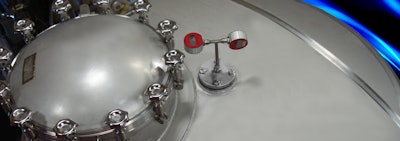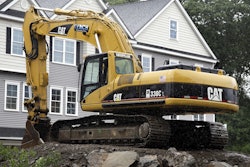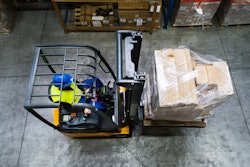
IDENTIFYING FACTORY TESTS AND CERTIFICATIONS FOR
ASME TANKS AND VESSELS
Factory Tests and Certifications for
ASME Tanks and Vessels
An important part of quality assurance is the process of manufacturing a
vessel and the completion of required certifications to meet ASME
compliance. Equally important is the understanding of these processes
and procedures, by all parties from project engineering managers to
purchasing teams.
Apache developed this white paper to serve as a general reference on the
types of factory testing required to meet ASME code compliance for the
manufacturing of stainless tanks and vessels.
In producing this white paper, Apache hopes to create a dialog about
quality testing and documentation to serve the compliance needs of our
customers and their large ASME and small/portable vessel projects.
Highlights include:
l A review of Factory Tests
l Manufacturing Processes that require Reporting
l An Overview of Certifications
l The Making of a Documentation Package
Discover How Factory
Tests are Conducted and
the Documentation
Required for
ASME Compliance
© Apache Stainless Equipment Corporation
2 © Apache Stainless Equipment Corporation
TESTING
Both Pneumatic and Hydrostatic tests require a
test pressure.
All tests are made by qualified and/or certified profes-
sionals following written practices or procedures.
Pneumatic Testing - ASME
The test requires the vessel to be filled with air. The tank
or vessel is pressurized to the test pressure. Leakage is
detected by bubbles in a leak detection solution.
Stringent safety procedures apply to the pneumatic test.
Code Ref.: UG100
Hydrostatic
The test requires that the vessel is filled completely with
water. Then the test pressure is applied. Leakage is de-
tected by visual inspection and/or pressure drops.
Code Ref.: UG99
Tanks are filled with water before applying the Hydrostatic
test.
© Apache Stainless Equipment Corporation 3
Liquid Penetrant
The tank or vessel is clean and dried. The penetrant is
applied (dipped, brushed, flooded or sprayed) to the
surface to be examined and allowed to penetrate into
defects or flaws. Excess penetrant is removed from the
surface and developer is applied. The examiners look for
bleed back of the penetrant into the developer to look for
cracks, porosity, lack of fusion and incomplete penetra-
tion and pits.
Code Ref.: UG100
Saline
Saline (salt solution) testing is used to test the quality of
the passivation. The surface to be examined is exposed
to the saline solution for a period of time. Surfaces are
then rinsed, dried and visually examined for flaws and
cracks.
Certificate
CIP (Clean In Place) Coverage
The purpose of a spray device coverage test is to test
spray patterns in process vessels for completeness of
spray coverage. The coverage test is not intended to
demonstrate cleanability, but rather the ability to deliver
cleaning solution to the target surfaces. The process is
to coat the target surface with a riboflavin solution run
the spray coverage equipment, then inspect for residual
riboflavin solution with a UV light. The vessel bottom,
impellers, dip tubes and ports are verified in the test.
Code Ref.: ASME BPE
Base Metal Thickness
Base Metal Thickness is a process of measuring the
thickness of vessel walls in a new condition using an
ultrasonic thickness testing device. Thickness readings
are mapped and reported to the vessel owner for future
comparisons to determine corrosion and wear.
Certificate
Continued on page 6.
The Penentrent test will produce a bleed if there are cracks
or pits in the tested material.
The Saline test requires a visual inspection.
The Spray Ball is tested to make sure that it covers the
required coverage areas of the vessel during CIP.
An ultrasonic device is used to test Base Metal Thickness.
Certifications
Next...
ASME U
4 © Apache Stainless Equipment Corporation
CERTIFICATIONS
ASME UM ASME R
The U mark certifies that the
pressured tank or vessel conforms
to the latest edition of the ASME
code and that the pressure vessel
has been designed and manufac-
tured in accordance with ASME.
All aspects are approved by a Third
Party ASME Authorized Inspector
(AAI). U stamps require an ASME
inspector to witness the ASME
hydro test.
Companies with a U mark undergo
a review with the National Board
every three years.
The UM mark, similar to the U
mark, also certifies that the pres-
sured tank or vessel conforms to
the latest edition of the ASME code
and that the pressure vessel has
been designed and manufactured
in accordance with ASME. The UM
vessels designation is related to
the size of the tank/vessel:
l Vessels 5 Cubic Foot of volume
or smaller with pressures not
exceeding 250 psi.
l Vessels 3 Cubic Foot of
volume or smaller with pres-
sures not exceeding 350 psi.
l Vessels 1.5 Cubic Foot of
volume or smaller with pres-
sures not exceeding 600 psi.
The National Board of Boiler and
Pressure Vessel Inspectors offers a
Certificate of Authorization and R
stamp for the repair or alteration of
boilers. pressure vessels and other
pressure retaining equipment.
ABOUT ASME
ASME is the acronym for the American Society of Mechanical Engineers.
The ASME Code Symbol is a compliance regulation for all Canadian
provinces and all 48 states in America.
ASME code Section 8 details mandatory rules regarding tank design from engineering, manufacturing and
testing of pressure vessels. Parameters such as wall thickness, material, flange rating and welding process
are determined by the application which includes pressure, temperature, corrosion allowance and fluid flow
in addition to requests from the customer. All these conditions are calculated and reviewed/approved by
the ASME inspector.
The NB mark is used
to identify certification
by the National Board
of Boiler and Pressure
Vessel Inspectors.
The UN (United Nations)
rating is an internationally
recognized system for
safe shipment required
by the DOT (Dept. of
Transportation.
© Apache Stainless Equipment Corporation
PED
5
SELO
The Pressure Equipment Directive (PED) is a Euro-
pean set of standards for the design and fabrication
of pressure equipment and vessels. It provides the
administrative requirement to allow for free placing
on the European market without legislative barriers. It
has been mandatory in Europe since 2002.
The SELO China Manufacturer License is an approval
procedure that qualifies the manufacturer to produce
pressure-bearing products, tanks and vessels.
PROCESSES
Material Trace allows manufacturers to trace items, such as raw materials, back to the supplier and
forward through production and installation of the equipment. Tracing helps manufacturers comply with
regulatory requirements and helps quality officers to analyze and develop an action plan to address any
variances in the quality of products and materials.
Welder Trace allows manufacturers to trace specific welder(s) on the projects and their specific
certifications.
Passivation is the removal of excess iron or iron compounds from the surface of stainless steel. Unlike
pickle passivation, no metal is removed from the surface during the process. The process has a negligible
effect on the RA values of the stainless material being passivated.
ASTM A967
Pickling is the immersion of the metal in a pickling bath or coating the material with pickling solution,
such as nitric-hydrofluoric acid. The process removes both iron contamination and heat-treating scales.
Pickle passivated stainless steel has a matte appearance. Apache’s tests have confirmed improvements
up to 25% in RA readings on material that has been pickle passivated.
ASTM A380
EP Electropolishing is an electrochemical process that removes surface material from stainless steel.
The process includes an immersion of the stainless-steel component into a temperature controlled bath of
electrolyte that is charged with a DC power supply. Electrolytes used in electropolishing are concentrated
sulfuric and phosphoric acid solutions. The finish has a mirror appearance. Apache’s before/after tests
have shown improvements in RA smoothness up to 50%; results vary depending on stainless material
and process time.
ASTM B912
6 © Apache Stainless Equipment Corporation
Ferroxyl Test
The Ferroxyl Test is a special test for locating iron residue
on stainless steel. The Ferroxyl solution is applied over
the area(s) that are to be tested. After a few moments,
the solution will show a blue color where iron is present.
Certificate
Positive Material Identification
Positive Material Identification (PMI) is a nondestructive
means of determining the chemical composition of met-
als. The test is performed by using one or two methods.
One, an x-ray flurescence that identifies the material key
element, but cannot detect carbon and lighter elements
and therefore has limitation. Two, optical emission spec-
troscopy. This method can detect all elements including
carbon and lighter elements but can be more costly to
perform.
Certificate
Ferrite Levels
Ferrite testing is a non-destructive method which pro-
vides data for austenitic stainless and duplex material.
The test determines the material corrosion susceptibility,
mechanical properties, service suitability and service re-
liability of the material being tested. Welds, construction,
components can all be tested.
Certificate
Radiography
Radiography tests can be conducted on-site as well as
at the customer location. Radiographic identification is
used to validate weld quality, inclusions porosity, lack of
penetration and lack of fusion. Imperfections are shown
on x-ray film.
Code Ref.: ASME BPE
UT Weld Testing
Ultrasonic (UT) weld testing uses the transmission of
high-frequency sound waves into material to detect
imperfections.
Certificate
The yellow solution in a Ferroxyl Test will turn blue if iron
is present on the area tested.
The PMI analyzer traces the correct materials.
This radiograph shows results from a test pipe.
UT weld testing will reveal weld quality.
DOCUMENTATION
PACKAGE
Turn Over Packet (TOP)
The Documentation Package or TOP is the final documentation for a tank or vessel project. Documentation
Packages are based on customer requirements. Packets may include:
l Certified drawings and calculations l Material test reports
l Material test reports l Welder qualifications
l Weld Procedures l Welder traceability
l Certificates / reports for required testing l Compliance (with standards) certifications
l Certificates for processes performed l Pickling/Passivation/Electropolishing Reports
l CE/SELO/UN Certifications
© Apache Stainless Equipment Corporation 7
Apache’s Commitment to 100% ASME Certified Welding Team
Apache Stainless constantly promotes manufacturing careers in Dodge County and on state and
federal levels. We work to educate high school students, and we support all the manufacturing
certificates and welding boot camp programs in Wisconsin’s Moraine Park Technical College system.
Welders come to Apache with a variety of experience levels. Some come in with significant
welding experience ready for certification. Others come as graduates of welding programs with a
desire to work at Apache. In those cases, Apache will invest in training and practice to ensure that
these professionals develop to the standards Apache’s production requires. New welders work along-
side Apache’s veteran welders and become ASME certified as required by the on-boarding process.
For over 40 years, Apache continues to maintain rounds of audits and inspections from ASME
compliance and safety professionals that speaks to the consistency of the welders – and the
effectiveness of the quality control department.
References:
ASME
National Boards of Boiler and Pressure Vessel Inspectors
Apache and Mepaco engineering experts and project library
About Apache
The Apache Stainless Equipment Corporation employs
experts and artisans in the fabrication of stainless
equipment for a range of industries. Our expertise in
stainless and high-alloy vessels is shown on Apache’s
tanks and vessels, and Mepaco’s food processing
equipment used in the beverage, biotechnology,
pharmaceutical and food processing industries.
ASME is a leading developer of codes and standards
in the mechanical engineering community. These
standards enhance public safety and health as well as
promote innovation. Apache has been ASME certified
for over 40 years.
In addition to ASME, Apache is also accredited in
many other global standards. By setting parameters for
quality and compliance, we offer greater value for our
equipment products.
Apache consists of four business groups: ASME tanks,
portable vessels, contract manufacturing and Mepa-
co®. With modifiable options, Mepaco’s product line
includes thermal processing equipment, mixers, blend-
ers, augers, dumpers, sanitary conveyors and material
handling systems.
Many of the equipment products manufactured by our
business groups use Apache’s in-house passivation,
pickle passivation, and electropolishing services.
As a 100% employee-owned company, Apache’s culture
exemplifies continuous improvement, efficiency, innova-
tion and commitment to our customer.
Phone: (920) 356-9900 or (800) 444-0398
E-mail: [email protected]
Web: www.apachestainless.com
200 W. Industrial Drive | Beaver Dam, WI 53916 USA
ASME stamp on a small vessel identification plate.
Apache has in-house passivation, pickle passivation and
electropolishing services.






















